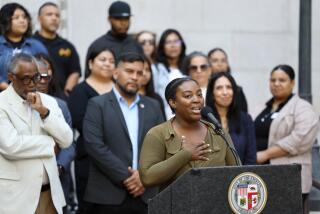Financial Assistance for Amnesty Applicants Falls Flat
Jack Shakely has a million dollars he is trying to give away, but he can’t find many takers.
The money comes from the Fund for New Americans, probably the only program in the nation set up to help undocumented immigrants pay the fees for the government’s amnesty. Shakely raised the money from some of the city’s biggest charities.
The desire to help Third World people in need was nothing new for the 48-year-old former Peace Corps volunteer. But like many before him, Shakely’s effort crashed against cultural barriers he didn’t anticipate.
In his otherwise careful calculations, Shakely failed to consider the immigrants’ mistrust of unknown institutions after years of living illegally. The program was under-publicized and too loosely structured to overcome such a formidable obstacle.
Low-Interest Loans
In fact, so few have taken him up on his program of low-interest, easy-to-get loans that most of the $1.75 million he raised will be left over, unused, after the legalization deadline passes on May 4.
The same fear, Shakely pointed out, is keeping perhaps half of the country’s 2 million illegal aliens from seeking amnesty.
“I’ve learned a lot about what makes a new American tick,” the baffled, soft-spoken humanitarian said the other day in his Wilshire Boulevard office.
A former university fund-raiser and past chairman of the Southern California Assn. for Philanthropy, he has been the president of the California Community Foundation since 1980. Over the last two years the nonprofit group has handed out $10 million in grants and awards for a variety of projects, from AIDS research to a free clinic for Central American refugees.
The Fund for New Americans, the foundation’s first loan program, got off to an impressive start last May. After Shakely’s convincing presentation, the board immediately voted to commit half a million dollars.
The Conrad Hilton Foundation liked the idea and kicked in $500,000, as did the James Irvine Foundation. The Ralph Parsons Foundation added another $250,000, and the response was so good, other interested charities were asked to hold off.
With the fund money in hand, Shakely went to the Security Pacific Bank, which agreed to take a loss and process the loans at a marginal cost. The media flocked to the kickoff press conference, where a smiling Shakely raised hopes that his program would boost the disappointing number of amnesty applicants.
“With application and processing fees, medical exams, fingerprinting, photocopying and notary public costs, families seeking amnesty may spend more than a thousand dollars just to apply,” Shakely said.
Through the Fund for New Americans, families would receive $425 in 10% loans (no previous credit history necessary), payable in 24 monthly installments of less than $20. Forty amnesty counseling centers in Los Angeles County would offer the loan applications.
Virtually every Latino community organization endorsed the plan, and U.S. officials asked Shakely to launch similar programs in Nevada and Arizona.
Ironically, Shakely at first worried about over-publicizing the program. “At the time I was reluctant to go all out because I was afraid that we wouldn’t be able to handle all the requests,” he said, sighing.
Applications Never Came In
During the first few days after the announcement, foundation employees worked nonstop answering inquiries and making referrals. But the soon phones stopped ringing. And the applications never came in.
“I was astonished,” Shakely said. “Thirty days later we hadn’t made a single loan.”
So far, less than 250 loans have been approved--not even close to the initial conservative estimate of 4,500. Another 130 applicants have been turned down for having bad credit; only one person has defaulted on the payments.
The great majority of the potential applicants, as Shakely found out, shied away from the financial opportunity. Undocumented immigrants, he discovered, face a big transition from underground economies, where loans are usually personal, to one where the use of credit is a way of life; from peasant societies where debts are a cause for shame to one where a history of no credit becomes a liability.
“Me, a loan? Nada , nada . I want none of it. If I buy something I pay cash if I can, and if not, I don’t buy anything,” said Ausencia Sandoval, 60, a garment worker who came from Guadalajara in 1980 and is applying for amnesty. “And if I really need money I ask the people around the house.”
Her remarks were echoed by many others in immigration centers.
“No, I don’t need a loan. I save my money cent by cent, “ exploded farm worker Arturo Castillo, 29, obviously insulted by the question. He would rather remain illegal than borrow.
According to Carmen Lima, a legal aide at the East L.A. Legalization Project, “Many are afraid that they will be investigated and that the information could be used against family members who do not qualify for amnesty.”
Of the project’s more than 3,000 amnesty clients, only six have applied for loans. Four have been turned down and none approved.
Father Greg Boyle of the Dolores Mission in East Los Angeles, which keeps track of 1,200 parishioners in the process of applying for amnesty, said immigrants shy away from the program because of fears they will be deported if they default.
‘A Lot of Them Are Poor’
“A lot of them are poor, and they live from day to day. Even setting aside $20 becomes a real luxury,” he said.
Also, pride often prevents poor immigrants from seeking help. “Several people told me that they missed their appointment with the INS, a once-in-a-lifetime opportunity, simply because they don’t have enough money to pay the fees,” he said.
As for those who do apply, “If they need money, they turn to their families. If not, they come here.” His parish has paid many amnesty fees, but Boyle will not say how many for fear the doorsteps of his church would be flooded with people asking for money.
Catholic Charities suggested that the foundation give away the money instead of lending it, but the very mention of such an idea makes loan program director Clifford Lum wince.
“If we just gave it away, we’d run out of money almost immediately, and we want to help people establish credit,” he explained.
Only Shakely is willing to take direct responsibility for the failure of the loan program, while others engage in finger-pointing.
Lum, for example, became defensive when asked about the program. “What else can I do? Who do I talk to?” he asked, throwing up his hands. “I’ve gone to the Spanish newspapers, the radios, I got (Spanish) Channels 34 and 52 to play public service announcements.”
Blames Legalization Agencies
He placed most of the blame on the legalization agencies. “I take the time to go out there,” he said, “train them, explain the process step by step, but it seems that many counselors don’t want the extra work, so they don’t push the loans too hard.”
Teresa Alva, East L.A. Legalization Project administrator, in turn faulted Lum.
“A lot of people are hesitant to take out the loans, and I don’t blame them,” she said. “The main problem is misinformation. Why doesn’t Lum have the INS publicize the program? Most people, when they come to an agency like ours, they already have the money for the fees.”
Lum said he is in the process of sending an information package to the INS. Spokeswoman Dona Coutlice said that the INS never publicized the program because Lum never got in touch with the agency.
Julie Kenney from the James Irvine Foundation said: “I have no idea what went wrong. . . . I’ve heard some criticisms (saying) that the bank made loan requirements too stringent.” On the other hand, Phil Long of Security Pacific noted: “If the immigrants were afraid to apply, it is the responsibility of the foundations and the agencies to do the outreach.” The Conrad Hilton Foundation’s Pat Modugno said the only reason he can think of for the low number of applicants is that the loan packages put together by the California Community Foundation “were too restrictive.” And so it goes.
Shakely freely acknowledged that there are many things he would do differently if he had to do it all over again--and he is still trying to make the best out of the program.
He has expanded the number of agency sites offering loans to 110, and the program’s territory to include eight counties, from Santa Barbara to San Diego. Two loan packages, for single adults and married couples, have been added to the initial parent-and-child package. Proof of holding a steady job is no longer required if the applicant can find a financially stable sponsor. Adjustments were made to make spouses of U.S. citizens eligible.
Changes Seem Helpful
The changes seem to be helping. Application requests have picked up, from 29 in October to a high of 113 in December, but that is still less than a trace of the almost 500,000 people expected to apply for amnesty in greater Los Angeles.
“I wish I could tell people, ‘Use this program; it’s a good way to get credit,’ ” Shakely said, shaking his head. “I wish. . . . “
Maybe the publicity should have been handled differently, Shakely mused. Maybe the foundation should have given away some money to people in extreme need. Maybe more immigrants would be interested if they could keep some of the money.
Shakely and Lum are now planning to use the fund’s untapped resources in education programs for new residents. In any case, Shakely sees value in what he still calls “my baby.” The loan program has helped him establish close relationships with the immigrant community, he said, and his work would be rewarded if even one person benefited.
One such person might be loan applicant Margarita Ramos, who said the loan would solve her money problems. But even she has reservations.
“To be honest, I am afraid to go to the bank (to make the payments). People that go to the bank are rich, they have nice dresses. I’ll have to dress with whatever I have and I’m afraid they’ll look at me and say ‘Who is she?’ ”
More to Read
Sign up for Essential California
The most important California stories and recommendations in your inbox every morning.
You may occasionally receive promotional content from the Los Angeles Times.










